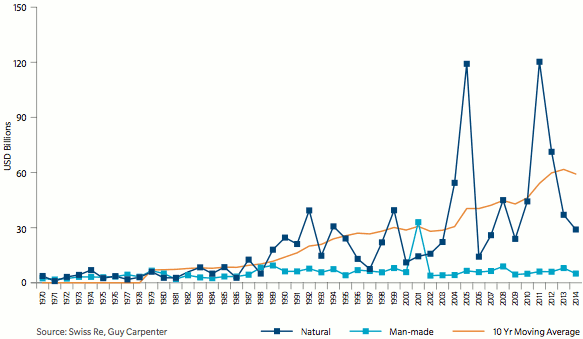Despite intense snowstorms in Japan, severe hail and windstorms in Europe, major flooding in parts of the UK and several aviation tragedies, global insured losses for 2014 were the lowest for five years, at roughly $33 billion, according to Guy Carpenter & Company, LLC.
The international risk and reinsurance broking specialist’s annual ‘Global Catastrophe Review’ report has recently been published, highlighting a significant drop in insured losses throughout 2014 from natural and man-made disasters.

Significant natural catastrophe insured losses 2011 to 2014 - Source: Guy Carpenter
The Americas, which includes the U.S. and Canada, contributed around 57% of the global insured loss figure, while Europe, the Middle East and Africa comprised roughly 21%, and Asia, Australasia regions fronted approximately 23% of the losses, according to Guy Carpenter’s study.
“Although insured losses for 2014 were among the lowest recorded in years, we still observed powerful impacts and significant losses from both natural and man-made catastrophes,” advised James Waller, Research Meteorologist at GC Analytics.
Interestingly, Artemis reported at the end of last year that Swiss Re’s sigma research unit had estimated 2014 global insured losses would reach $34 billion, while reinsurer Munich Re provided a global catastrophe insured loss figure for 2014 of just $31 billion.
Similarly, and again differing from Guy Carpenters review, Aon Benfield’s Impact Forecasting division recently reported that catastrophe insured losses for 2014 were 38% below the ten-year average, at $39 billion, also discussed by Artemis.
Regardless of varied totals from several of the world’s leading brokers and reinsurers it’s clear to see that whether at the high or low-end of estimates, 2014 was someway below previous years and long-term averages.
The low-level of catastrophe losses has of course been exacerbating the softening of catastrophe reinsurance pricing. With traditional reinsurers and insurers finding the levels of loss manageable, excess has built up which alongside growing alternative capital results in ongoing pressure on rates.
Of course, this is not a bad thing for anyone, except perhaps for traditional reinsurers who are more accustomed to higher margins on this catastrophe exposed business. Lower reinsurance costs ultimately benefit insurance consumers and force capital to be more efficient, something that ILS excels at.
Guy Carpenter’s report notes that in Europe, the most notable loss event was windstorm Ela, which impacted large parts of Germany, as well as areas of France, Belgium and Austria, Guy Carpenter notes that this event caused insured losses of roughly $2.8 billion.
For the Asia, Australasia regions of the world several aviation tragedies throughout the year caused devastation, although the report does not provide any insured loss estimates.
China, the Philippines and Vietnam felt the brunt of the most impactful storm to hit the region in more than 30 years, Typhoon Rammasun, which totalled insured losses of $250 million, and economic losses of $4.6 billion.
The U.S. and Canada witnessed an extremely harsh winter, with many pats of the states experiencing the coldest winter in three decades; this alone caused insured losses of $2.3 billion. While hurricane Odile’s presence in Mexico caused insured losses of roughly $1.6 billion.
Waller concluded that; “Although 2014 was a relatively quiet year for catastrophes, events such as Odile and Gonzalo reaffirm the importance of continued education and the implementation of innovative risk management strategies to mitigate the losses experienced from a catastrophe.”
In the report Guy Carpenter describes its $33 billion figure as “a dramatic drop when compared to the historic insured losses seen in 2011, which totalled approximately $126 billion.”

Global significant insured catastrophe losses 1970 to 2014 - Source: Guy Carpenter
One thing a decreased volume of insured losses does bring to light is the issue surrounding low levels of insurance penetration in certain regions of the globe, most notably in parts of Africa, India and Asia.
Although the Guy Carpenter review focuses on total global insured losses, Swiss Re’s sigma unit estimated economic losses of up to $113 billion during 2014, with Munich Re posting a similar number, at $110 billion.
Aon Benfield’s Impact Forecasting department provided an economic loss estimate for the same year of $132 billion, and while this again moves upwards from that of Swiss Re and Munich Re, it still highlights a continuing industry theme, being the vast gap between insured and economic losses.
As the reinsurance market sits awash with excess capital in traditional and alternative forms, the deployment of some of this capacity would be put to good work in innovative, emerging global markets, helping to increase insurance penetration levels and ultimately narrow the gap between insured and economic losses.
Here lies the opportunity for those who might complain about low property catastrophe reinsurance rates.
Create products and find ways to deploy excess capacity into regions where this gap needs to be narrowed. Sell new covers direct to the world’s mega-corporations, who hold significant amounts of catastrophe risk on their balance-sheets.
For reinsurers pressured by low catastrophe reinsurance pricing the choice is clear, find ways to use your capacity or become more efficient to lower your margin requirements. While catastrophe losses remain low there is no sign of rates increasing, and even if catastrophe losses return to long-term average levels there is no guarantee that the rates known previously will ever return anyway.
 View all of our Artemis Live video interviews and subscribe to our podcast.
View all of our Artemis Live video interviews and subscribe to our podcast.
All of our Artemis Live insurance-linked securities (ILS), catastrophe bonds and reinsurance video content and video interviews can be accessed online.
Our Artemis Live podcast can be subscribed to using the typical podcast services providers, including Apple, Google, Spotify and more.































